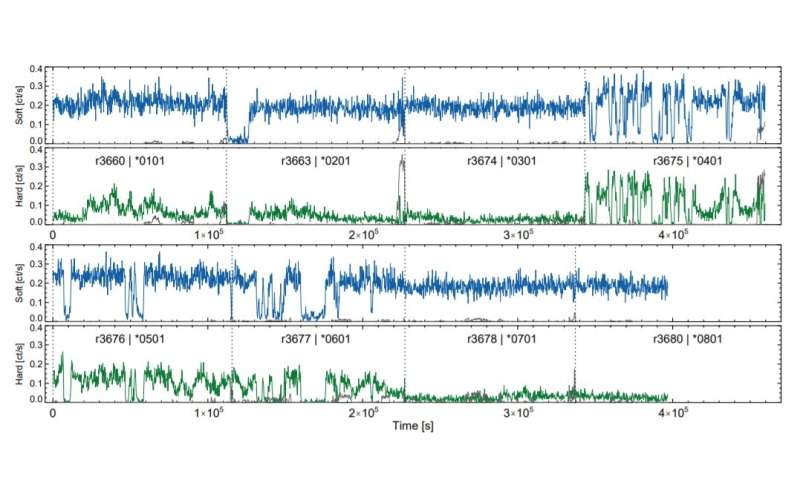NGC 247 ULX-1: Background subtracted light curves for 8 new XMM-Newton observations with
Astronomers have performed a timing analysis of the ultraluminous X-ray source NGC 247 ULX-1 using ESA's XMM-Newton spacecraft. The study detected quasi-periodic dipping in the X-ray light curve of this source. The finding is reported in a paper published April 22 on the arXiv pre-print server.
Ultraluminous X-ray sources (ULXs) are point sources in the sky that are so bright in X-rays that each emits more radiation than 1 million suns emit at all wavelengths. They are less luminous than active galactic nuclei (AGN), but more consistently luminous than any known stellar process. Although numerous studies of ULXs have been conducted, the basic nature of these sources still remains unsolved.
NGC 247 ULX-1 is a supersoft ULX in the intermediate spiral galaxy NGC 247 located some 11.1 million light years away. It switches between the soft ultraluminous X-ray state and the supersoft ultraluminous state. Previous observations of NGC 247 ULX-1 suggested the presence of strong dips in source flux in its light curve. Such dipping behavior is still poorly understood, but it may indicate that we are viewing these sources at high inclination or it may be evidence for a precessing disc.
A team of astronomers led by William Alston of the European Space Astronomy Center (ESAC) in Madrid, Spain, has investigated NGC 247 ULX-1 with XMM-Newton, hoping to confirm the presence of dips and to shed more light on their properties.
"NGC 247 ULX-1 was observed eight times by XMM-Newton over one month, starting December 3, 2019. Seven observations have duration ∼ 115 ks and one lasts for ∼ 55 ks. Two short (∼ 35 ks) observations from 2016 are not included in this analysis as they are too short to probe Fourier frequencies below ∼ 1 × 10−4 Hz," the researchers wrote in the paper.
The observations revealed deep and frequent dips in the light curve of NGC 247 ULX-1 on 1,000 to 10,000 s timescales. The amplitude of these dips increases with increasing energy bands as the variations are larger at higher energies in both the dip and no-dip epochs.
Time series change point analysis found that the dip periods most likely cluster around 5,000 and 10,000 seconds. This is consistent with the peak timescales observed in the power spectra. However, several broad dips (with periods over 15,000 seconds) have also been identified, which suggests an alternative mechanism for these longer duration dips.
According to the authors of the paper, the results show that the detected quasi-periodic dips in NGC 247 ULX-1 might be associated with some structure present in the outer disc where the photosphere becomes optically thin. They noted that the presence of dips and their long timescales support the scenario in which soft ULXs are primarily seen along the edge of the wind.
"The dips can be caused by either the occultation of the central X-ray source by an optically thick structure, such as warping of the accretion disc, or from obscuration by a wind launched from the accretion disc, or both. This behavior supports the idea that supersoft ULXs are viewed close to edge-on to the accretion disc," the astronomers explained.
More information: Quasi-periodic dipping in the ultraluminous X-ray source, NGC 247 ULX-1, arXiv:2104.11163 [astro-ph.HE] arxiv.org/abs/2104.11163
© 2021 Science X Network
























